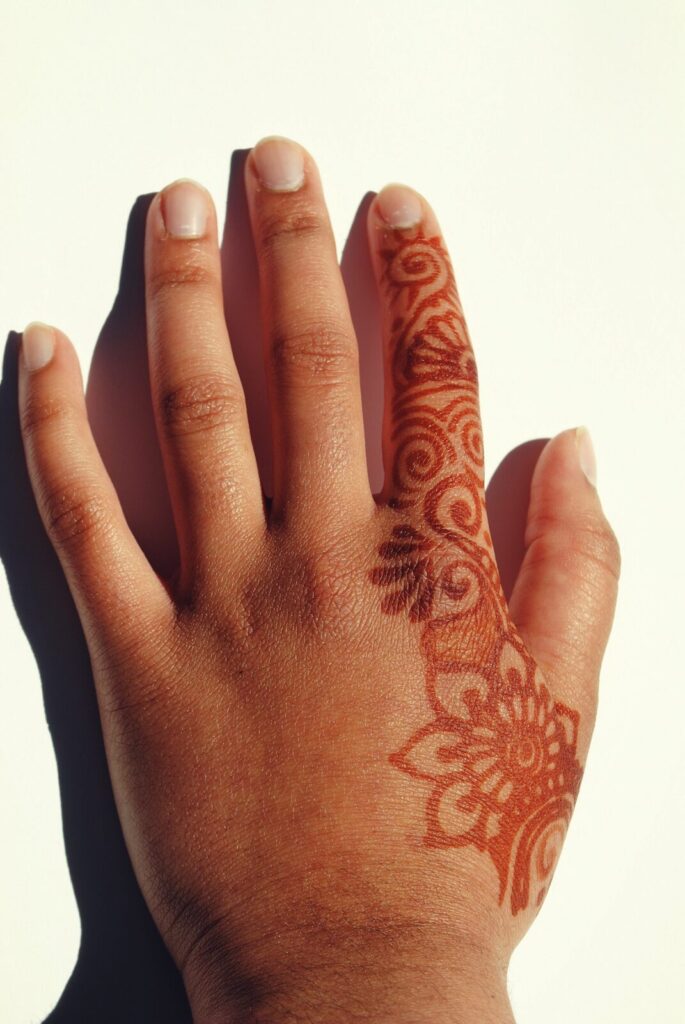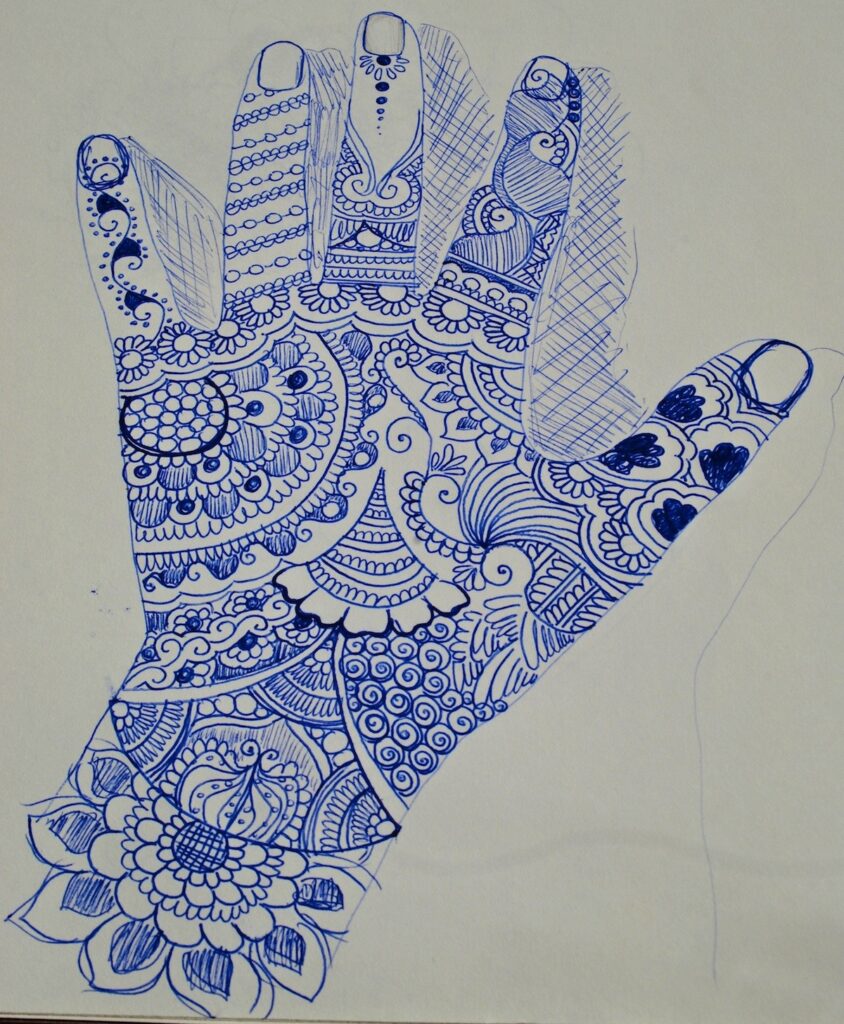Merav Eres graduated in the Class of 2015 of Sayre School. She worked as an intern for UnderMain producing a series of posts pertaining to arts in the schools. In this last piece of her series, Merav profiles and interviews two high school artists, one a visual artist exploring a traditional art form of her culture, the other a performing artist in dance planning to take her art to the next level. Merav will be attending Tel Aviv University in the fall.
Hina Iqbal is a seventeen-year-old 2015 Sayre School graduate. Hina plans to attend UK with a Singletary Scholarship in the BS/MD program. She will be majoring in biology and minoring in neuroscience in order to continue on to medical school. Hina’s parents are both from Pakistan and, as a result, she became interested in mendhi. Mendhi is the Urdu (the official language of Pakistan) word for henna. She has become very passionate about this form of art and has introduced it to the Sayre community.

UM: What would you say mendhi is if you had to explain it to someone who knew nothing about it?
Hina: So mendhi comes from a leaf that you grind up into a paste. It’s mixed up with some other organic ingredients and then the paste is used for decorative designs on your body. Once the paste dries it leaves an orange stain on your skin that lasts anywhere from one week to a whole month. It was first used in the sub-Saharan region and the Indian subcontinent because the paste itself had a cooling effect. People would put it on their palms, which helped keep their hands and feet cold. Eventually, people started using it in celebrations, particularly wedding ceremonies. Today it continues to play a large role in Pakistani culture.

UM: When did your interest in mendhi start?
Hina: Well, I remember when I was really young we used to visit Pakistan once or twice a year, and one time at my grandfather’s house some of my aunts were running around with mendhi cones doing designs on the kids. So I definitely grew up with it from an early age, but I don’t remember an exact moment when I was as interested or passionate about it as I am now. Once I started middle school and high school I became more interested. Over time I get a lot better and really fell in love with it.
UM: What makes you so passionate about mendhi?
Hina: Well, one reason that I love it so much is just for the purpose of drawing and having something to do. It’s such a beautiful design. It’s an artistic outlet or me and fun to do, plus it means so much culturally to me that it’s the perfect combination. I remember when I was younger I would go to school festivals and do mendhi on people, but the teachers would say it’s a distraction or like a tattoo. This was something that means so much to both family and me. My mother, my grandmother, it’s important to all of us so when I have mendhi on my hand I feel proud of my culture and I want to show people that this is something to celebrate. Embracing diversity and where you come from is so important, rather than just conforming to what everyone else wants. Eventually the teachers got used to it and now it’s the number one hit during Sayre’s fall festival. It’s just a matter of opening up people to what it actually is. You can’t blame them for not knowing something unless they continue that ignorance after you’ve explained what it is. The most important thing is communication and open conversation. You want to make other people feel comfortable coming up to you and asking questions even if they think its sounds dumb. I encourage people to ask me about mendhi. It’s really tied to my identity. It’s a physical display of where I come from and of my culture.
[aesop_quote type=”pull” background=”#ffffff” text=”#000000″ align=”center” size=”3″ quote=”Embracing diversity and where you come from is so important, rather than just conforming to what everyone else wants. ” parallax=”off” direction=”left”]
UM: How have you brought mendhi into the community?
Hina: When I entered high school I found out you could easily create a club. All you needed was a group that was interested so I decided to do that in the 10th grade. I got a teacher sponsor and we started the club with meetings every Monday for practice. Then I started teaching people in the club where mendhi is used, why it is used, and what kind of importance it has for the people in those places. I wanted to give them a sense of depth and a glimpse of the tradition behind it. That deserves to be recognized so they don’t think mendhi is just something you go and get at the beach.
UM: In what ways does mendhi differ in certain areas as opposed to others?
Hina: The designs have really evolved from place to place. In Africa, typical mendhi designs are made up of geometric patterns, lines, zigzags, and dots. In the Middle East places like Saudi Arabia and Qatar have really flowy, flowery, and swirly designs that are open and less intricate. As for Pakistan, the designs are insanely intricate. India’s mendhi style is similar to Pakistan’s but a little less intricate. It’s amazing how many different styles are out there. You can really do what ever you want with it. It’s so cool how different countries and groups have taken that freedom and made traditional designs out of it. You can do anything you want with mendhi and that’s definitely part of why I love it so much.
UM: What would you say to people using mendhi as a result of its trendiness?
Hina: The thing is this is meant for decorative purposes, so if someone from another ethnicity decides to use it as a decorative piece that’s awesome. However, I hope people don’t think about it as a fleeting trend because it’s so important and distinctive of our culture. It can be degrading to the meaning but it’s great when people do it in a respectful way and know a little bit about what they’re doing.
UM: As you go off to college how do you plan to take mendhi with you?
Hina: Basically I want to continue sharing mendhi in the form of a club at UK. I hope that by continuing to introduce mendhi to people there then there’ll be a more inclusive, understanding kind of environment at my school.
_____________________________
Ella White is a seventeen-year-old junior at Lafayette High School. Ella is a dancer and is looking to attend college for dance and acrobatics. She has been acting and dancing since she was 12 years old. Ella joined the dance company ‘Black Bird’ four years ago. The group is separated into junior and senior artistic groups. She is in the senior company, which focuses on acrobatics, aerialist silks, and apparatuses.
UM: How did you begin dancing?
Ella: I joined a theater group when I was seven called Academy for Creative Excellence and met my current dance teacher, Jenny Fitzpatrick, who is the founder of Black Bird Dance Theater. I always loved to preform when I was younger so it was easy for me to be attracted to new artistic outlets like dance.
UM: What is your dance company like?
Ella: Black Bird Dance Theatre is a pretty small company so everyone knows everyone. It’s very family oriented. It’s not like most dance companies because everyone is really supportive and no one has a sense of entitlement. All the dancers are equal. We’re all there to focus on our training, experiment, and push ourselves. We don’t do traditional ballet point dancing. We do a lot of tap, jazz, contemporary, and technique. Right now we are working on silks and aerial stuff. This year our winter production was “Uglyâ€, which is a self-written show by our dance teacher, Jenny. The show contained hip-hop, ballet, contemporary, jazz, and even tap. We also preformed “Cats”, the musical, this year. Right now the senior company is working on our rendition of “Romeo and Juliet”.
[SlideDeck2 id=5252 ress=1]
UM: What is your favorite type of dance?
Ella: My favorite type of dance is pop-jazz because it’s up-tempo and hard. I like being challenged as a dancer because it really helps me grow. The dance world is really competitive so you have to get tough quickly. I also enjoy hip-hop and lyrical. What it really boils down to is getting to express myself with my body, and if I’m doing that then I don’t really mind what style of dance I’m doing it in.
UM: Do you have your own fears about pursuing dance?
Ella: Yeah, definitely. I’m afraid of pursing dance as a career because you hear lots of horror stories from people coming back from New York because they couldn’t afford to live there. They didn’t make it. But I have realized that it’s more important to study what you love and take the chance, because if you don’t take the chance you will never know. If I don’t make it I will just do something else. That fear kind of makes me want to double major, but I don’t think I’m going to do that because nothing is as important to me. So why would I do something that I’m not going to enjoy?







